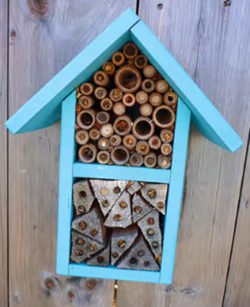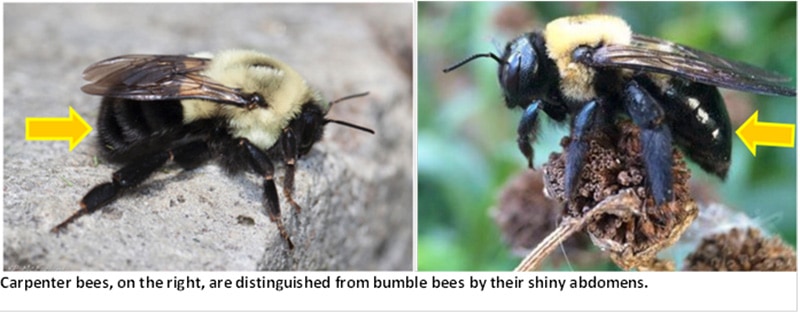By Michele Colopy, Program Director, Pollinator Stewardship Council
If carpenter bees are chewing into your deck or house trim, you can deter them in the following ways:
Cover or fill carpenter bee holes
This year, insert some steel wool in the current holes in the deck or house trim, fill in the hole with wood putty, and paint it to match the house or deck. The carpenteer bees that emerged in the spring from those holes will return to that site to lay new eggs. Filling the holes will make your home less attractive.
Give carpenter bees a bee house
Purchase or make a bee house that includes solid wood boards and hang it near where the bees are flying or trying to make a nest.
At the end of November, move that native bee house to the far end of your property, posting it to a fence or tree. When the carpenter bees emerge next year that will be the home they return to.

The difference between bumble bees and carpenter bees
Bumble bees are often confused for carpenter bees due to their similar appearance.
Carpenter bees are mostly lacking hair on their shiny abdomen. Often, carpenter bees fly fast and erratically. Bumble bees fly slower, and “bumble” along due to a shorter wingspan.
Bumble bees tend to make a nest in the ground, often in former chipmunk or mouse burrows. Native bees will lay their eggs, provide them with food, and many of those eggs will emerge next spring to pollinate plants. Carpenter bees lay their eggs in a tunnel they chew into dry wood.

Discourage bees from making your home their home
Always repair, seal, or fill any holes in your deck or exterior parts of your home. This will deter rodents and insects, especially bees, from nesting or entering and causing damage to your deck or home. All critters are opportunists. And carpenter bees will take advantage of any available hole in wood.
Resources on native bees
You can use the free pollination services of native bees by providing them a place to live that does not damage your home.
- Learn about native bee nests you can create from Michigan State University Extension.
- Learn more about managed and native pollinators from the Pollinator Stewardship Council.
Bee pictures from the Maryland Dept. of Natural Resources dnr.maryland.gov/wildlife/Pages/habitat/wabees.aspx

